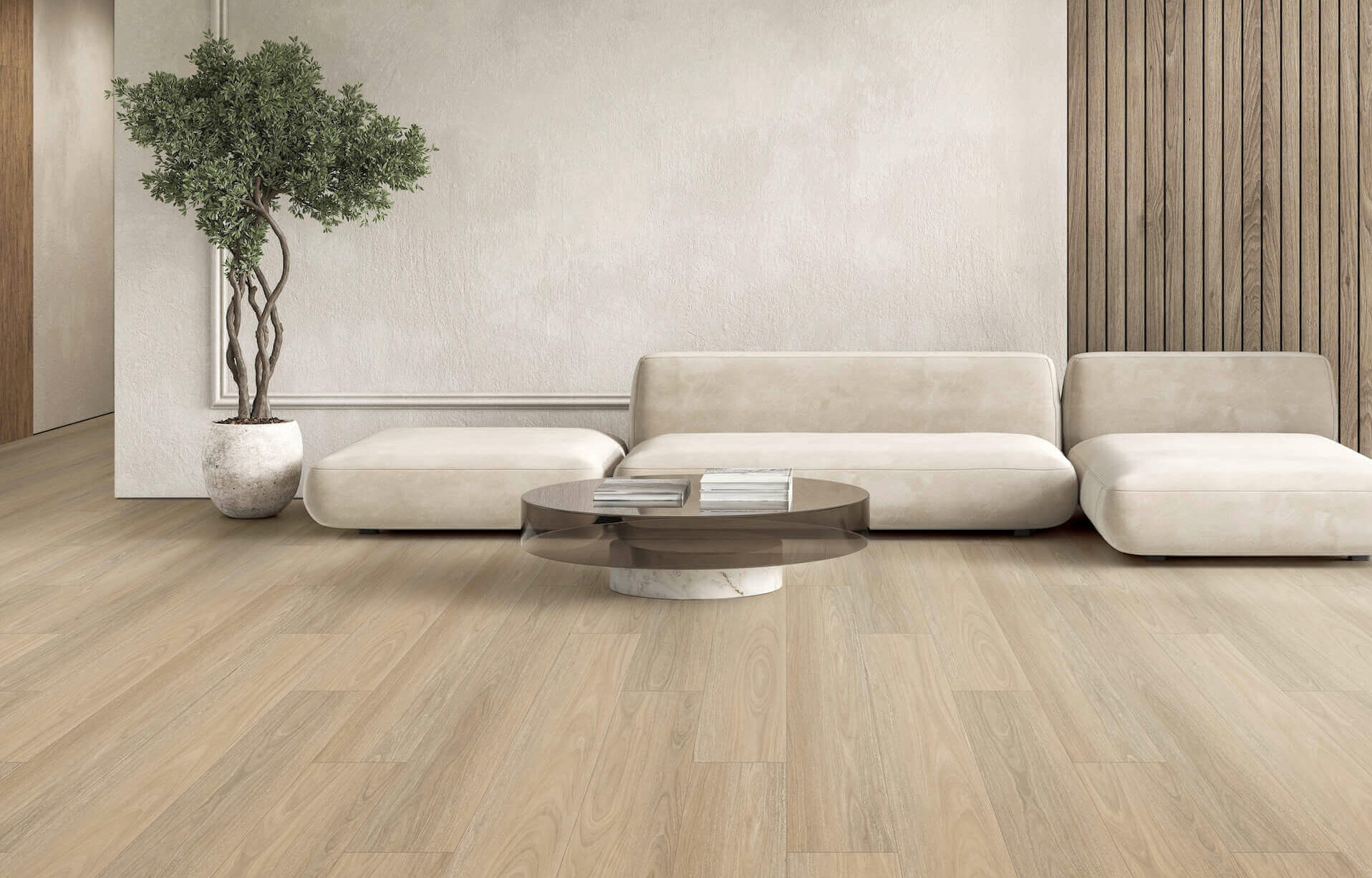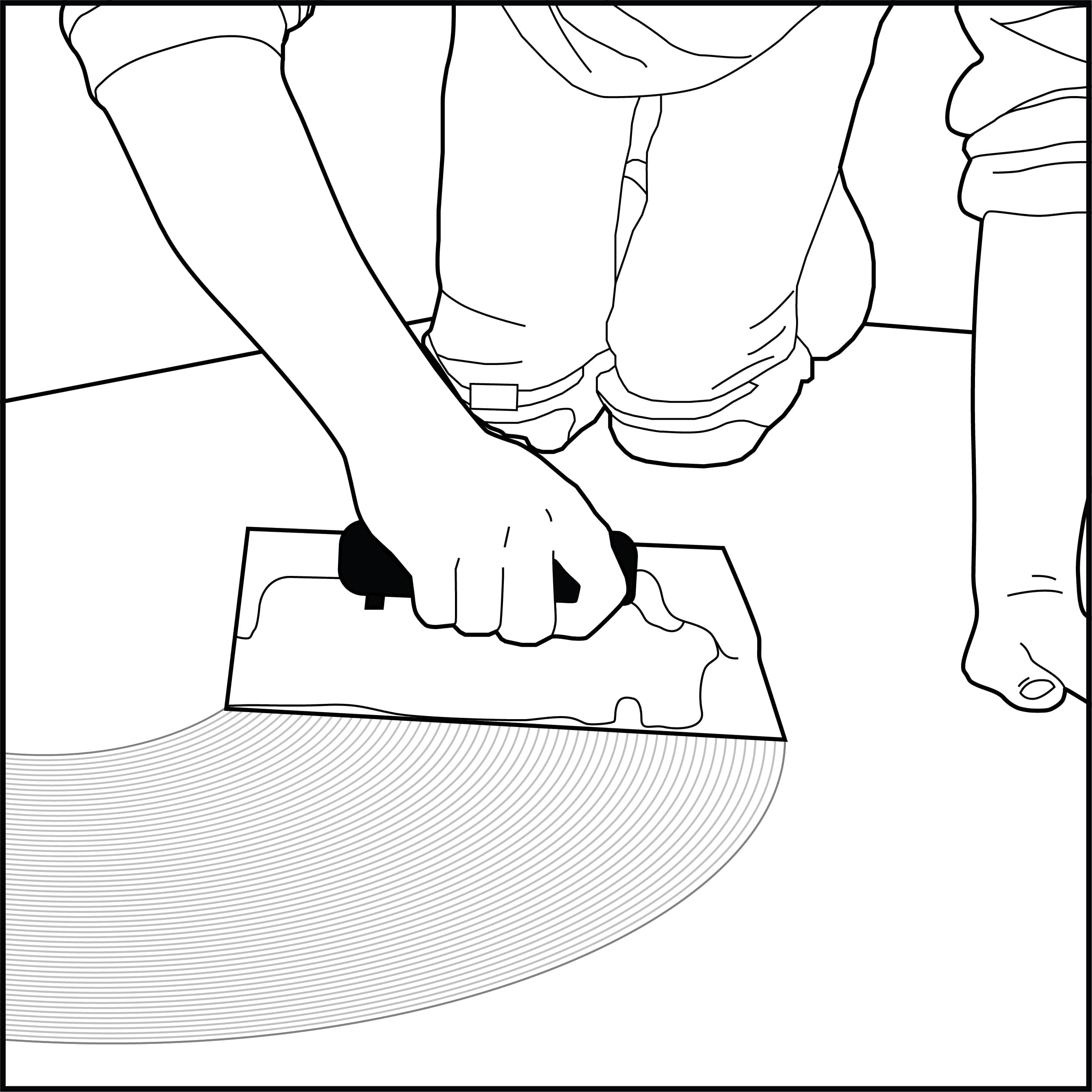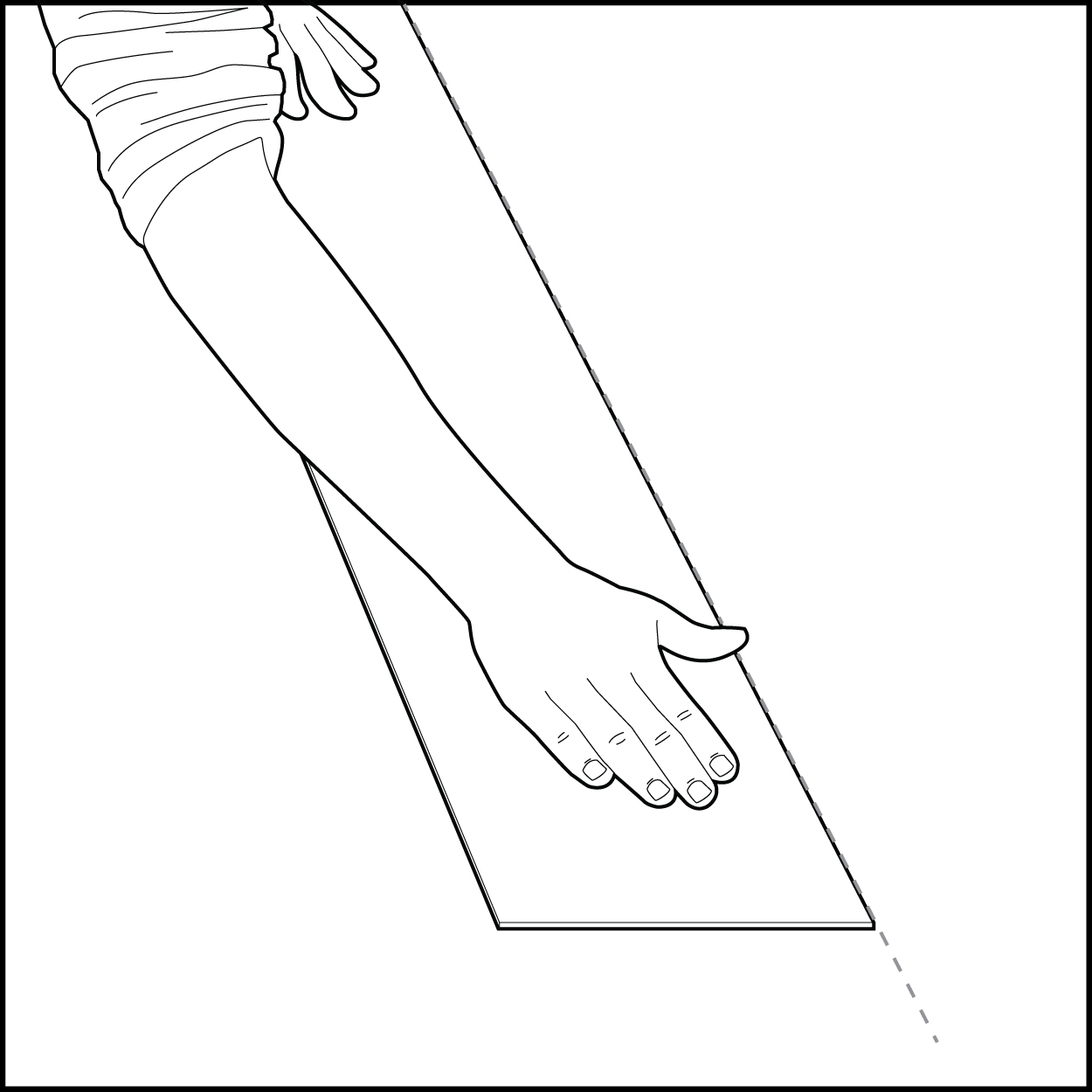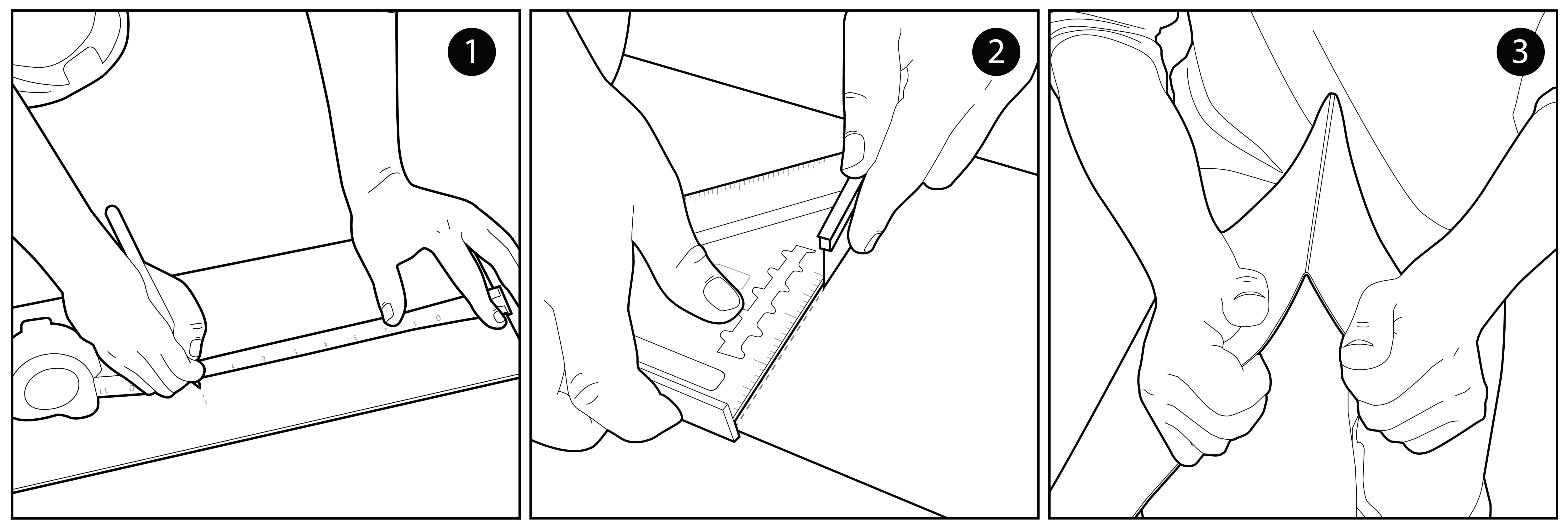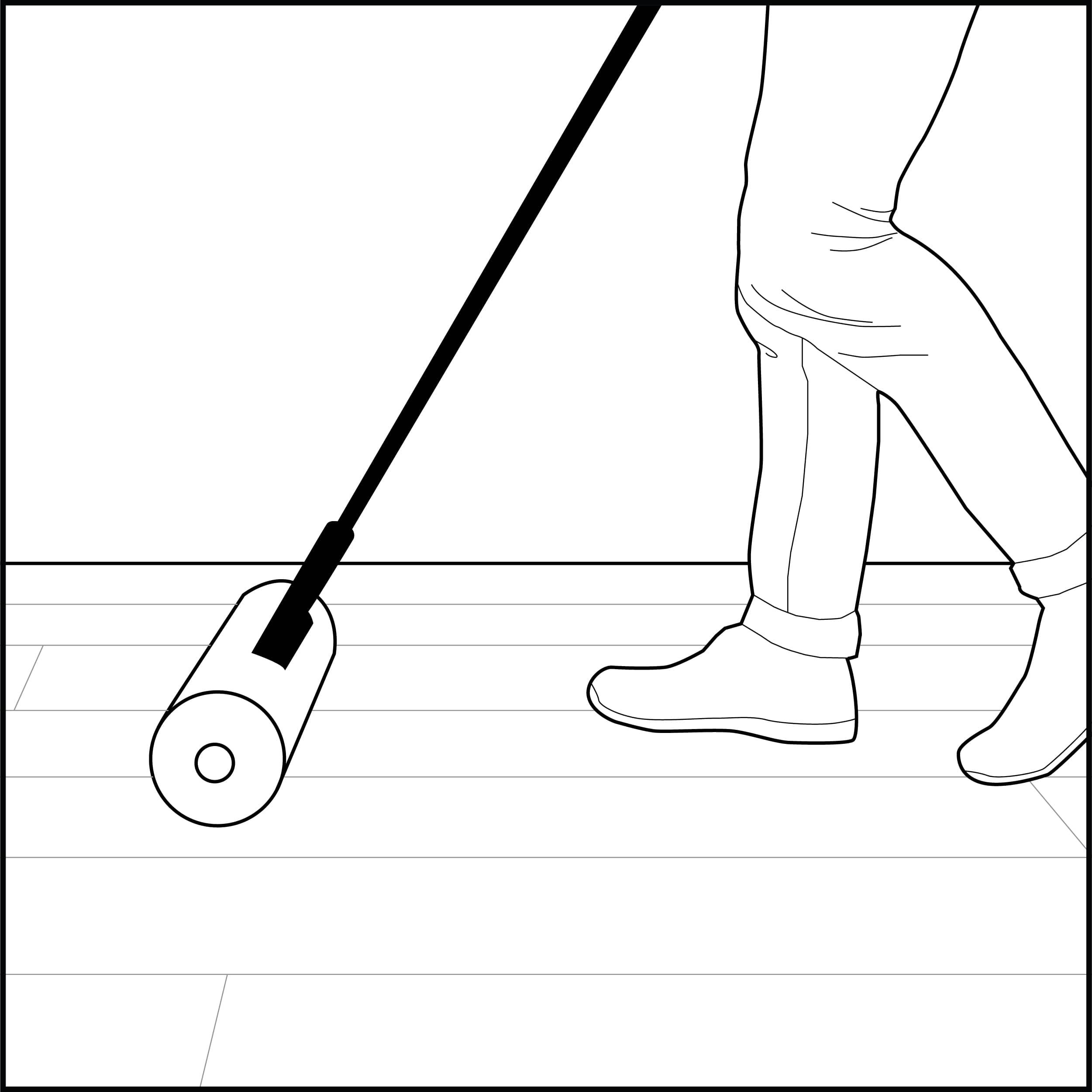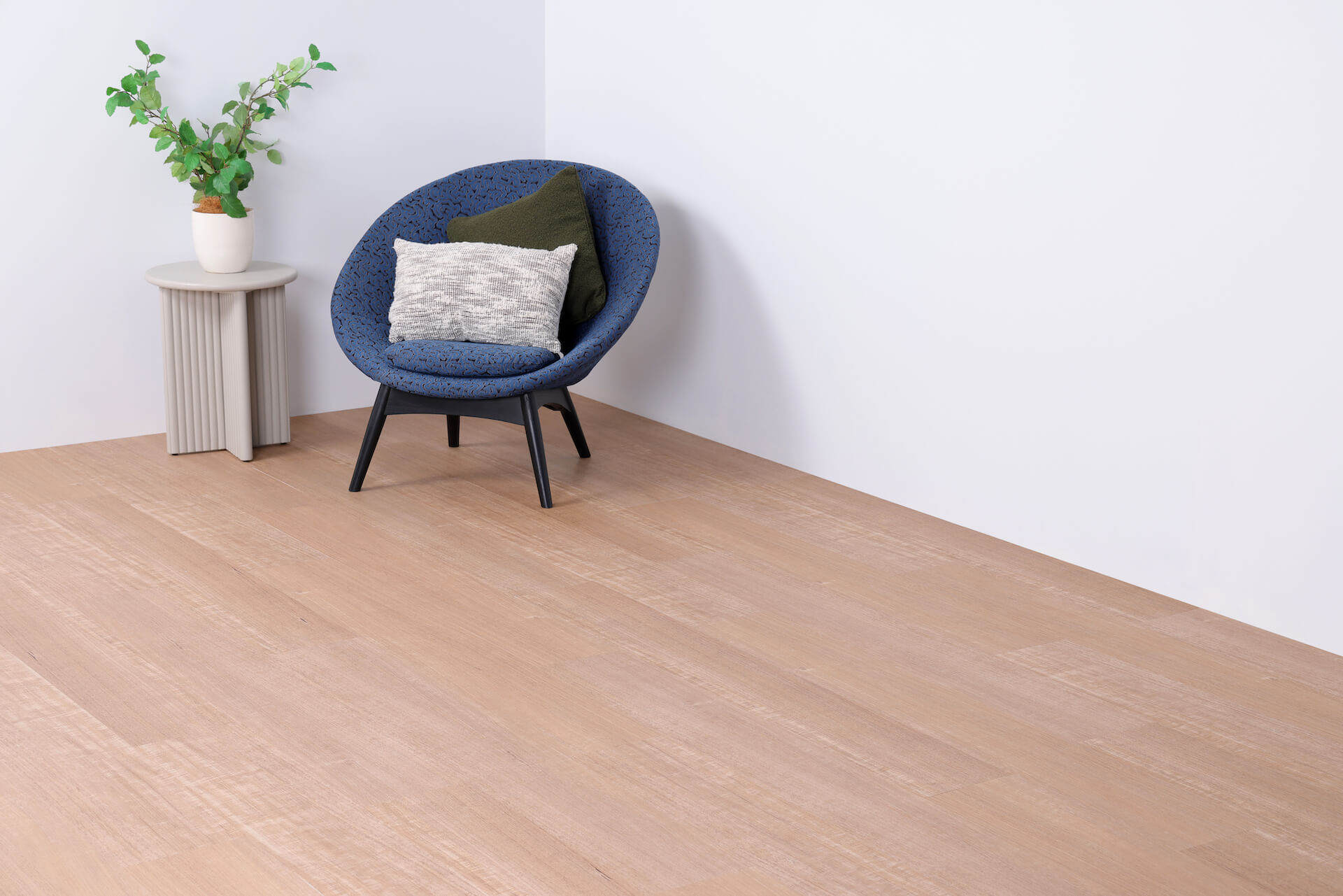Laying vinyl flooring (vinyl planking) is a fantastic way to enhance your home’s interior aesthetic. It’s an affordable, durable, and stylish option that a DIYer can install with a basic skill level. Proper cleaning preparation and installation methods are the key to successfully laying vinyl planks.
Though many terms still exist today, the only way to safely lay vinyl planks is by gluing them with a hard set vinyl adhesive to the subfloor. Our decades of experience in the flooring industry guarantee the best tips and techniques for a professional result. This blog guides you through detailed steps for vinyl floor installation.
Area and Subfloor Preparation
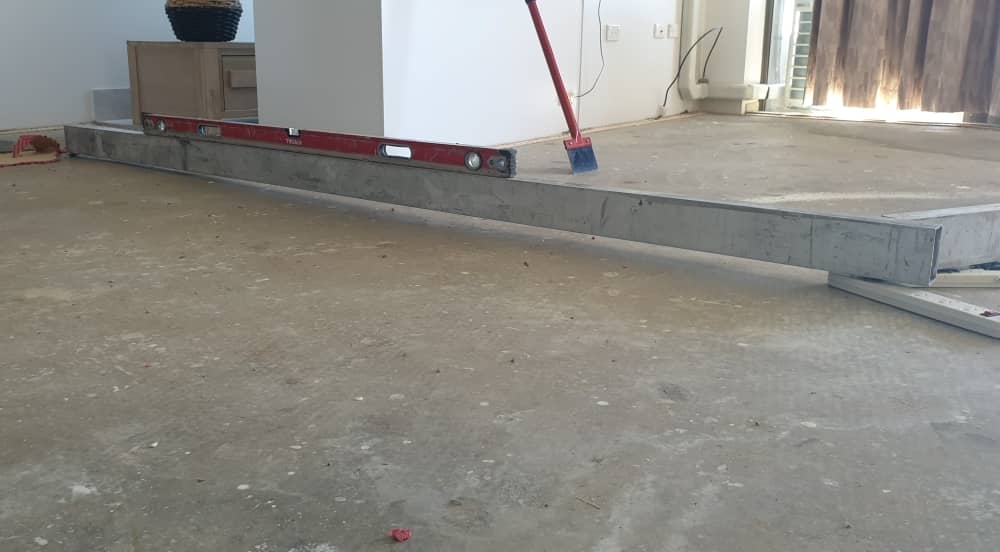
This image shows that the subfloor needs levelling work done by a professional to meet supplier warranty guidelines.
Proper subfloor preparation is crucial for a successful vinyl flooring installation. Every product supplier has an installation guide on the Online Flooring Store website, which is essential to read because the parameters and what you can get away with will vary slightly from product to product.
Each installation guide will tell you the floor’s level has to be flat within certain measurements or tolerances.
For example, they might say the flooring can have no more than 3mm deviation over three metres. What this means is that over a three-meter span of flooring, the level cannot rise or dip more than 3mm, which would compromise the product. They tell you the level to which the flooring has to be flat.
By using a straight edge of 2 metres or greater in length, you can move across the floor and check the level is within the manufacturer’s guidelines. If you see space beneath the straight edges or you can rock it on high points, you need to measure this distance to determine whether it is within tolerance.
If the measurement is outside of tolerance, there will be one of a selection of steps you will need to take:
Getting the floor level is critical for the longevity of the floor.
- For concrete subfloors, a self-levelling cement compound can fill in the spaces. Additionally, if some areas are overly high, a grinder can flatten them.
- On an older chipboard floor or a yellow tongue, the joins will often rise and peak over time. This is because moisture gets into the most vulnerable points: the joins. These must be sanded flat with a belt sander, checking as you go.
- Laying over existing timber flooring means you also have to make sure all edges are flat using a sander. For a timber floor, it is best to lay your new flooring at a 90-degree angle to the existing flooring. This means that if your timber flooring is running North to South, you will want to run your new flooring from East to West.
- Laying over tiles proves more problematic because of sudden drops. Drops from one tile to another can often drop 4-5mm alone. That area presents an issue because underneath the product, at these points, it is unsupported. This causes stress on the boards, which are then transferred into the joints of your flooring. Over time, the joins will deteriorate and break. A grinder is a perfect tool combined with using the self-levelling compound. Typically, you must grind the tips off the edges and high points and use a self-levelling compound in the dips. Wide grout joins may cause problems, but most products can withstand regular grout joins.

Expert Insights From Clem Sturgess
20+ years' experience in hard flooring
In addition to the points above, when laying vinyl over the yellow tongue, timber or tiles, you will likely need to lay a sheet of masonite stapled down to the floor first. We recommend closely adhering to supplier guidelines on this.
Here are the overall steps to ensure your floor is ready:
- Acclimate Vinyl Planks – Let the vinyl planks acclimate to the room’s temperature for at least 1 hour before installation. This ensures that the planks don’t shrink during installation, as they are usually brought straight in from the back of a hot truck.
- Remove Old Flooring – Ensure the subfloor is free from any old flooring materials. This might involve scraping off old adhesive or removing carpet. Make sure you do not damage the subfloor during this process.
- Clean and Level the Surface – Before vinyl flooring installation, the subfloor must be clean, dry, and level. Sweep away any debris, vacuum the area, and use a damp mop if necessary.
Please read this article on subfloor preparation. Its importance is unquestionable, and this is a topic in itself.

Expert Insights From Clem Sturgess
20+ years' experience in hard flooring
Leveling uneven subfloors is usually best left to a professional. It can be hard to get right, and unless done correctly the first time, it can cause you to have it done a second time anyway.
.

Expert Insights From Levi Saunders
Online Retail Specialist & Flooring Content Creator
If you need acoustic attenuation, you must use a very high-density rubber underlay. You must also check that the Vinyl Plank Flooring and the underlay are compatible.
Scotia vs Skirting
Decide whether you are going to remove skirting. If you leave the skirting on, you must put scotia on the top of the skirting and flooring afterwards. Scotia is a corner concave piece of decorative moulding (usually wood) that will cover a flooring gap without removing skirting. It is fixed over the skirting and floorboards around the flooring perimeter.
Be sure to number scotia and skirting with the wall as you take it off. If you decide to reinstall it later, you will know exactly where it will go.
Plan the Layout
Measure the room and plan your plank layout for the vinyl planks. It’s essential to start with a straight line, typically from the longest wall. Use a chalk line to mark your starting point. You must know how many plank widths and lengths your room is. Read this blog on exactly how to calculate and measure floor space.
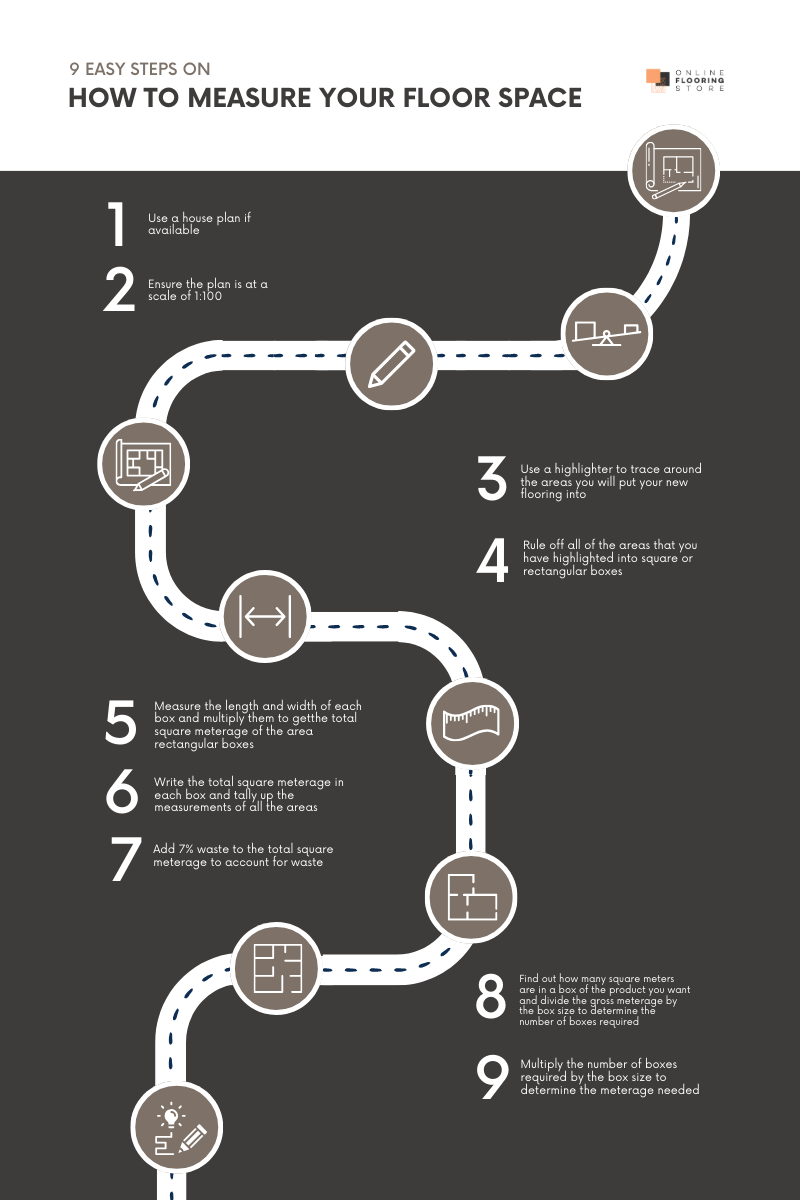
A diagram showing how to measure floor space.
Tools and Materials Needed
Gather all the necessary tools and materials before laying vinyl flooring. Having everything ready will make the installation process smoother and more efficient.
Tools Required
- Tape Measure: For accurate measurements of your room and vinyl planks.
- Chalk Line: To mark straight lines for your starting point and ensure even placement.
- Razor Knife: Essential for cutting vinyl planks to size.
- Trowel: For spreading adhesive if you’re using the glue-down method.
- Floor Roller: To ensure a strong bond between the planks and the subfloor, particularly for self-adhesive and glue-down methods.
- Pencil: This is for marking where you are going to cut planks.
Materials Needed
- Vinyl Planks: Ensure you have enough planks to cover the area, plus a few extra for mistakes and future repairs. Use this article to determine how many vinyl planks/boxes you need.
- Adhesive: You will need to use a hard-set vinyl plank adhesive. For the best results, choose an adhesive recommended by the vinyl plank manufacturer.
The Walk Through
Walk across the floor and identify areas that could be potentially difficult to install. For example, if you are laying in one direction, you may discover it’s easier to lay around door jams on one side of the floor vs. the other. Spend time familiarising yourself with the job at hand and looking at difficult areas. Once you have determined the direction in which the flooring will go plan how you will deal with those areas.
You can escape grief and heartache later on by taking a good walk. Please familiarise yourself with how you will lay the floor & simulate it in your head before starting. When you reach the problematic points, you have already workshopped on tackling them.
Installation Methods
- Once upon a time, different installation methods were available for vinyl plank flooring. Today, most suppliers only allow the installation of vinyl planks with a hard-set adhesive. This means that when the adhesive sets, it sets hard and does not allow the plank to move.
- Suppliers have chosen this path because vinyl planks, while waterproof, are made mainly of PVC and are affected by temperature. This is difficult for Vinyl in a country with many climates, as the product grows in the heat and shrinks in the cold.
- Unlike Timber and laminate products, which grow and shrink due to ambient moisture ingress or release over a period of time, Vinyl planks grow and shrink rapidly, often within minutes, when exposed to rapid temperature changes.
- One thing to be aware of. Some products claim they can still be loosely laid, glued directly to chipboard and yellow tongue, or glued using pressure-sensitive adhesive. These claims should be viewed with a certain amount of scepticism. While they are not entirely untrue, you can be heading for trouble without much knowledge of the product and your environment.
Using Hard-set Adhesive
- As the name suggests, Hard Set Adhesive glues a plank to the floor with a hard adhesive that dries. This not only stops the planks from moving around the floor but, in a perfect world, also stops them from growing and shrinking.
- It is essential that before laying vinyl planks, they have had at least an hour inside your house to acclimate after they come in off the back of a truck. If they are brought in off the back of a truck exposed to the sun, the planks are likely to have grown. If you lay these in this state, they will likely shrink while the adhesive is setting, leaving permanent gaps in your floor.
- Most suppliers have defaulted to this method because it is the least likely to cause problems. Interestingly, this was the only option available when vinyl planks first came out in their early forms. After years of trying other methods and some very costly mistakes, we have ended up right back where we started.
Why Do We Only Recommend Hard-set Adhesive?
As I look down my list of suppliers and their LVT (luxury vinyl tiles) product offerings, I see many products made side by side in the same factories, but the suppliers importing them have differing views on how they may be installed. Having worked on the supplier side of the industry for many years, there are specific little indicators and tricks that you pick up that allow you to recognise what another supplier is doing to create a perception that their product, which is identical to yours, is, in fact, superior.
- If a supplier says that their product may be loosely laid (meaning no adhesive is used) over top of the chipboard, and everyone else says this is not possible, then you would think that this makes it a superior product. However, this is not the case; it is some clever marketing.
- Each supplier knows that most jobs will work in this application, but the one that fails is a costly problem to rectify. Most companies err on the side of caution and say that they can’t do it.
- However, if you know that most work and are the only one allowing this installation method, you will pick up everything from this product category in this installation application.
- However, you also know that one in ten jobs will fail. So, how do you avoid this? Well, it is done through very cleverly worded installation and warranty documents.
Read the Fine Print
I remember years ago when I was a rep for a tile company, and one of the largest suppliers in the country was advertising a limited lifetime warranty on all of their tiles. My interest peaked, so I entered a showroom and got a copy of the document. The document stated that ‘once the tiles were removed from the box, they were no longer covered’. But they were warranted for a lifetime, you just weren’t able to use them. The Devil is always in the details, so read supplier guidelines carefully!

Expert Insights From Clem Sturgess
20+ years' experience in hard flooring
Because the flooring is stuck down with hard set adhesive, it cannot move, and there is little need for expansion gaps. This means you will not have to remove skirting and can lay the flooring against it.
How to Install Vinyl Flooring Using Hard-set Adhesive
Once you have completed the preparation steps, install your vinyl plank flooring using the glue-down method.
Here are the steps you need to follow:
-
Spread the Adhesive
Begin by using a trowel to spread the adhesive evenly at a 45-degree angle. Applying the adhesive in a consistent pattern is important to avoid lumps. After spreading, wait for 45-90 minutes until the adhesive feels tacky and changes colour. This indicates it’s ready for the vinyl planks. Remember that you should follow the guidelines for the specific adhesive you use.
-
Lay the First Plank
Start your installation by laying the first plank against the wall, skirting, or along the pre-drawn guideline. Following this guideline is crucial to maintaining a square layout throughout the room. Adhesiveness is also unforgiving later on if you initially get it wrong, so make sure each plank is where it needs to be.
Laying the first row of vinyl up against the guideline.
-
Cutting Vinyl Planks
You must likely cut the last plank to size to finish the starting row. Here’s how:
- Mark the plank at the required length using a pencil.
- Score the top of the plank twice with a scalpel, using a set square for precision.
- Make a final cut for a clean separation. Alternatively, you can use a guillotine for a quick and precise cut.
- Repeat this process for each plank until the starting row is complete.
-
Adjust the Edge Row
For the edge row, measure the required width and modify the planks accordingly:
- Place the planks for the edge row on top of the starting row.
- Use a loose piece of flooring to trace a line against the wall.
- Cut the planks along the traced line using a straight edge and scalpel.
- Install these planks snugly against the wall, ensuring no gaps.
-
Secure and Clean the Flooring
After laying all the planks, use a 34-45 kg roller to firmly secure the flooring. This step ensures the adhesive bonds properly, providing a lasting installation. Finally, clean the surface to remove any debris or adhesive residue.
If you follow these steps, you will achieve a professional and durable finish.
-
Scotia & Skirting Installation
This is where you look at the trims you need to finish the flooring off and install scotia or reinstall skirting.
If you are reinstalling the skirting, simply follow the numbers you put on the back of them and work your way back around the house. If you decide not to take the skirting off and install scotia, the rule is to keep a business card’s width between the scotia and the flooring below. This will prevent the scotia from being too tightly installed against the floor, prevent any potential for it to ‘pinch’ the floor, and prevent necessary raft movement.
Old Installation Methods
Loose Lay Vinyl Planks
Loose-lay vinyl planks were a fantastic concept, and a vinyl plank could be laid with no adhesive by simply placing it on your floor. It was a groundbreaking concept as it was waterproof and almost immediately destroyed sales of laminate flooring in the country. If a plank was damaged, it could be taken up with a butter knife, and a new plank could be laid in its place—no adhesive or fuss.
Additionally, all the testing had been done to prove that the product would not grow and shrink, and nothing else was required. It was a dream come true! But the dream soon became a nightmare.
The ‘Scientifically Proven’ testing did not simulate our environment. While we completed a percentage of jobs, many were not successful. Everyone panicked, and we tried numerous methods to stabilise an inherently unstable product. Initially, we were instructed to glue the perimeter of the floor. Then, it became every fourth row, a grid bond, and a full pressure-sensitive adhesive. Before long, hard-set adhesive became the norm, and it has stuck (pardon the pun) to this day.
Self-Adhesive Vinyl Planks
A Self-adhesive vinyl plank has a peel-and-stick adhesive on the back. This fantastic invention would allow laypeople to create professional products. Let’s say there is a good reason you will not find these products in any flooring store in the country that maintains responsibility for product warranties.
With our current technology, there is just no way to have a peel-and-stick adhesive that has the traction to bond a vinyl plank to a subfloor permanently. You will only find these in hardware stores that sell flooring, where the customer’s expectation differs from that of one looking for a quality, permanent flooring option.
Floating Vinyl Plank Flooring
This was another idea to bridge the gap between vinyl plank and laminate flooring and was, in some ways, the inspiration for Hybrid Flooring.
- Floating Vinyl Planks (I use the past tense for a good reason) were vinyl planks with a laminate-style locking system cut into the perimeter of the boards. They would then be installed in the same way as a laminate floor, but it would be much easier as the entire installation could be done with a knife.
- This was another failed concept, and it always came back to vinyl’s temperature sensitivity. The locking system was very small and cut into something soft. When heat expanded the product, it softened as it grew, destroying the joint, which was the most fragile part of the plank.
You will typically only find these now in the Flooring Museums’ ‘What were we thinking’ department.
Direct Sticking Using Pressure Sensitive Adhesive
This method arose from the need to solve the issues of loose-lay vinyl planks and has been quite successful in many areas.
- Pressure-sensitive (PS) adhesive is the kind used under carpet tiles. It is designed not to harden but to create traction, allowing damaged planks to be replaced just as easily as loose-lay planks while still adhering to the floor.
- PS Adhesive does not truly harden, so it does not control vinyl planks’ growth and shrinkage. It creates enough traction on the floor so that in a contracted state, where there are small gaps between planks, the planks do not move (migrate) when walked on.
- This way, when they return to their normal state, the planks in some areas will not be too close to each other and cause bunching.
- This has been successful in many areas, especially where the temperature remains fairly consistent. However, there have been enough areas where it has not worked for most suppliers to put a red line through this installation method for heat-sensitive vinyl flooring.
Ready to Start Your Vinyl Flooring Project?
Contact us today for more tips and professional advice to make your DIY flooring installation successful. With our expert guidance, you can confidently transform your space with beautiful, durable vinyl flooring.
Vinyl Installation FAQ’s
Yes, a beginner can install Vinyl Plank Flooring. Follow the rules and the installation guide, and take your time. We only recommend directly sticking the product,ct, which can be more complex than applying but is perfectly achievable for a DIYer with basic skills.
It is always better to glue vinyl planks with rigid vinyl adhesives. This will ensure the best possible installation. Due to the product's anatomy, direct sticking is the only safe way to get the best long-term results with vinyl planks.
Sticking a Vinyl Plank ensures the best possible result, inhibiting the product's ability to grow and shrink with temperature changes.
The choice is always personal and should be weighed against the advantages and disadvantages of other flooring types. In these cases, people usually decide that this is the best flooring type for their requirements.
It is best to let the product sit for a few hours and give the adhesive time to bond successfully.
It would help if you allowed the product to sit in the environment where it is being installed at room temperature for a few hours. Refer to the installation guide, which will inform you of the best temperature range at which the product should be installed.
Generally, you will get what you pay for all flooring types. Most vinyl planks that reputable companies import will be of good quality as they have to back their warranties. If you buy directly from someone selling a product they are importing, it can often be more challenging to tell.


